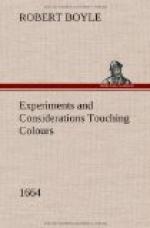B D & [beta] [delta]. Those refracted Rays which are partly refracted towards E & [epsilon]. and there paint an Iris 1 2 3 4 5. denoting the five consecutions of colours Red, Yellow, Green, Blew, and Purple; and are partly reflected towards F & [zeta].
D F & [delta] [zeta]. Those Reflected Rays which are partly refracted towards G & [eta]. colourless, and partly reflected, towards H & [theta].
F H & [zeta] [theta]. Those reflected Rays which are refracted towards I & [iota]. and there paint an other fainter Iris, the colours of which are contrary to the former 5 4 3 2 1. signifying Purple, Blew, Green, Yellow, Red, so that the Prism in this posture exhibits four Rainbows.
I know not whether you will think it Inconsiderable to annex to this Experiment, That we observ’d in a Room not Darken’d, that the Prismatical Iris (if I may so call it) might be Reflected without losing any of its several Colours (for we now consider not their Order) not onely from a plain Looking-glass and from the calm Surface of Fair Water, but also from a Concave Looking-glass; and that Refraction did as little Destroy those Colours as Reflection. For by the help of a large (double Convex) Burning-glass through which we Refracted the Suns Beams, we found that one part of the Iris might be made to appear either beyond, or on this side of the other Parts of the same Iris; but yet the same Vivid Colours would appear in the Displac’d part (if I may so term it) as in the other. To which I shall add, that having, by hiding the side of the Prism, obverted to the Sun with an Opacous Body, wherein only one small hole was left for the Light to pass through, reduc’d the Prismatical Iris (cast upon White Paper) into a very narrow compass, and look’d upon it througn a Microscope; the Colours appear’d the same as to kind that they did to the naked Eye.
EXPERIMENT VI.
It may afford matter of Speculation to the Inquisitive, such as you, Prophilus, that as the Colours of outward Objects brought into a Darken’d Room, do so much depend for their Visibility upon the Dimness of the Light they are there beheld by; that the ordinary Light of the day being freely let in upon them, they immediately disappear: so our Tryals have inform’d us, that as to the Prismatical Iris painted on the Floor by the beams of the Sun Trajected through a Triangular-glass; though the Colours of it appear very Vivid ev’n at Noon-day, and in Sun shiny Weather, yet by a more Powerfull Light they may be made to disappear. For having sometimes, (in prosecution of some Conjectures of mine not now to be Insisted on,) taken a large Metalline Concave Speculum, and with it cast the converging Beams of the Sun upon a Prismatical Iris which I had caus’d to be projected upon the Floor, I found that the over-powerfull Light made the Colours of the Iris disappear. And if I so Reflected the Light as that it cross’d but the middle of the Iris, in that part only the Colours vanish’d or were made Invisible; those parts of the Iris that were on the right and left hand of the Reflected Light (which seem’d to divide them, and cut the Iris asunder) continuing to exhibit the same Colours as before. But upon this we must not now stay to Speculate.




